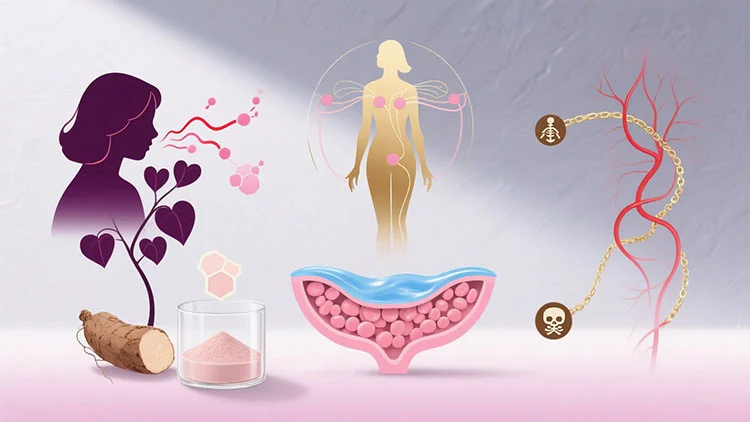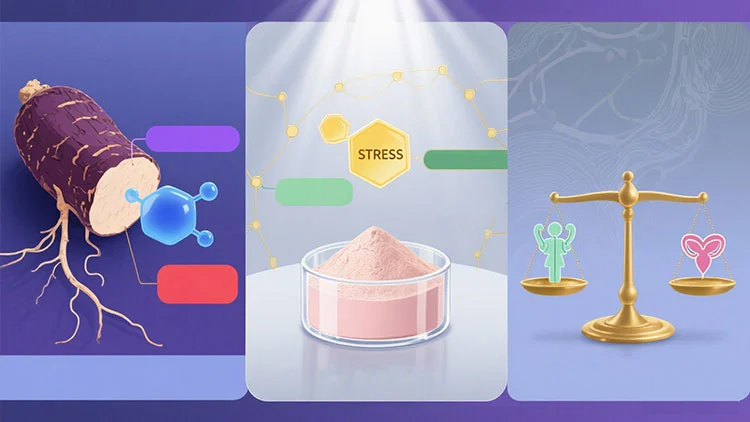How Does Pueraria Extract Influence Hormonal Balance?
Pueraria extract, derived from the roots of Pueraria lobata (commonly known as kudzu), has garnered significant attention in the realm of natural health supplements due to its potential to influence hormonal balance. This powerful botanical extract contains a rich array of bioactive compounds, particularly isoflavones, which have been shown to interact with the endocrine system in remarkable ways. As we delve into the intricate relationship between Pueraria extract and hormonal equilibrium, it's crucial to understand how this natural remedy may offer support for various hormone-related concerns, from menopausal symptoms to testosterone regulation. The following exploration will shed light on the mechanisms by which Pueraria extract may help modulate hormone levels, potentially offering a natural approach to addressing hormonal imbalances and their associated symptoms.
Key Phytoestrogens in Pueraria Extract: Daidzein and Puerarin's Role in Estrogen Modulation
The Chemical Structure and Estrogenic Activity of Daidzein
Daidzein, a prominent isoflavone found in Pueraria extract, plays a crucial role in its estrogen-modulating effects. This compound shares structural similarities with estradiol, the primary form of estrogen in the human body. Due to this resemblance, daidzein can bind to estrogen receptors, albeit with lower affinity than endogenous estrogen. This interaction allows daidzein to exert mild estrogenic effects, potentially helping to alleviate symptoms associated with low estrogen levels. Research has shown that daidzein's estrogenic activity may be particularly beneficial during menopause, when natural estrogen production declines. The Pueraria extract's high content of daidzein contributes to its potential as a natural alternative for hormone balance, offering a gentler approach compared to synthetic hormone replacement therapies.
Puerarin: A Unique Isoflavone C-Glycoside and Its Hormonal Effects
Puerarin, another key phytoestrogen found in Pueraria extract, is distinguished by its unique chemical structure as an isoflavone C-glycoside. This compound is particularly abundant in the kudzu root and has been the subject of numerous studies investigating its hormonal effects. Puerarin's molecular structure allows it to interact with estrogen receptors in a manner distinct from daidzein, potentially offering complementary benefits. Research suggests that puerarin may help modulate estrogen levels by influencing the expression of estrogen-related genes and enzymes involved in estrogen metabolism. The presence of puerarin in Pueraria extract enhances its overall estrogenic activity, contributing to the extract's potential to support hormonal balance, particularly in scenarios where estrogen supplementation may be beneficial.
Synergistic Effects of Daidzein and Puerarin on Estrogen Signaling
The combination of daidzein and puerarin in Pueraria extract creates a synergistic effect that may enhance its overall impact on estrogen signaling. While each compound can independently interact with estrogen receptors, their combined presence may offer a more balanced and comprehensive approach to estrogen modulation. This synergy could potentially lead to more effective management of estrogen-related symptoms without the risks associated with high-dose single-compound interventions. The Pueraria extract's complex phytoestrogen profile, dominated by daidzein and puerarin, provides a multi-faceted approach to supporting estrogen balance. This natural blend of isoflavones may offer a more nuanced and physiologically compatible method of addressing hormonal imbalances, particularly for individuals seeking alternatives to conventional hormone therapies.

Clinical Evidence: Pueraria Extract's Impact on Menopause Symptoms and Estrogen Balance
Studies on Pueraria Extract's Efficacy in Reducing Hot Flashes
Clinical research has provided compelling evidence for the efficacy of Pueraria extract in alleviating menopausal symptoms, particularly hot flashes. Several studies have focused on the extract's ability to reduce the frequency and intensity of hot flashes, one of the most common and distressing symptoms of menopause. In a randomized, double-blind, placebo-controlled trial involving postmenopausal women, those who received Pueraria extract supplements reported a significant reduction in hot flash frequency compared to the placebo group. The phytoestrogens in Pueraria extract, primarily daidzein and puerarin, are believed to be responsible for this effect, as they may help stabilize estrogen levels and modulate thermoregulatory function. These findings suggest that Pueraria extract could offer a natural and effective option for women seeking relief from menopausal hot flashes without resorting to hormone replacement therapy.
Improvements in Vaginal Health and Lubrication
Another significant area where Pueraria extract has shown promise is in improving vaginal health and lubrication in postmenopausal women. Declining estrogen levels during menopause often lead to vaginal dryness and atrophy, causing discomfort and affecting quality of life. Clinical studies have demonstrated that women using Pueraria extract experienced improvements in vaginal lubrication and overall vaginal health. The estrogenic effects of the extract's isoflavones are thought to stimulate the production of vaginal secretions and maintain the integrity of vaginal tissues. In one study, participants reported increased vaginal moisture and reduced discomfort during intercourse after regular use of Pueraria extract. These findings highlight the potential of Pueraria extract as a natural alternative for addressing vaginal symptoms associated with menopause, offering a safe and non-invasive option for women seeking to maintain vaginal health and sexual well-being.
Long-term Effects on Bone Density and Cardiovascular Health
The long-term benefits of Pueraria extract on bone density and cardiovascular health have also been subjects of clinical investigation. Estrogen plays a crucial role in maintaining bone density, and its decline during menopause increases the risk of osteoporosis. Studies have suggested that the phytoestrogens in Pueraria extract may help mitigate bone loss by promoting osteoblast activity and inhibiting osteoclast function. In a longitudinal study, postmenopausal women taking Pueraria extract supplements showed slower rates of bone mineral density loss compared to those not taking the supplement. Additionally, research has indicated potential cardiovascular benefits, with some studies reporting improvements in lipid profiles and vascular function among women using Pueraria extract. These findings suggest that the hormonal modulating effects of Pueraria extract may extend beyond symptom relief, offering potential long-term health benefits for postmenopausal women.

How Pueraria Extract Modulates Testosterone and Cortisol Levels for Hormonal Equilibrium?
Influence on Testosterone Production and Metabolism
While Pueraria extract is primarily known for its estrogenic effects, recent research has uncovered its potential influence on testosterone levels as well. Studies suggest that certain compounds in Pueraria extract may interact with enzymes involved in testosterone metabolism, potentially leading to modest increases in free testosterone levels. This effect could be particularly beneficial for men experiencing age-related declines in testosterone production. The mechanism appears to involve the inhibition of aromatase, an enzyme that converts testosterone to estrogen. By modulating this conversion process, Pueraria extract may help maintain a more balanced testosterone-to-estrogen ratio. Additionally, some research indicates that the isoflavones in Pueraria extract might stimulate the production of luteinizing hormone (LH), which plays a crucial role in testosterone synthesis. These findings suggest that Pueraria extract could offer a natural approach to supporting healthy testosterone levels, potentially benefiting muscle mass, bone density, and overall vitality in men.
Effects on Cortisol Regulation and Stress Response
Pueraria extract has also shown promise in modulating cortisol levels and improving the body's stress response. Cortisol, often referred to as the "stress hormone," plays a vital role in the body's reaction to stress but can have detrimental effects when chronically elevated. Research indicates that certain compounds in Pueraria extract may help regulate the hypothalamic-pituitary-adrenal (HPA) axis, which is responsible for cortisol production. In animal studies, Pueraria extract administration has been associated with reduced cortisol levels under stress conditions. This effect is thought to be mediated through the extract's interaction with neurotransmitter systems and its potential adaptogenic properties. By helping to normalize cortisol levels, Pueraria extract may contribute to improved stress resilience, better sleep quality, and enhanced overall well-being. These findings suggest that Pueraria extract could be a valuable natural tool for managing stress-related hormonal imbalances and supporting adrenal health.
Balancing Act: Pueraria Extract's Role in Overall Hormonal Homeostasis
The ability of Pueraria extract to influence multiple hormone systems underscores its potential role in promoting overall hormonal homeostasis. By simultaneously modulating estrogen, testosterone, and cortisol levels, Pueraria extract may offer a comprehensive approach to hormonal balance. This multi-faceted action is particularly relevant in addressing complex hormonal disorders or age-related hormonal changes that affect both men and women. For instance, the extract's estrogenic effects may benefit postmenopausal women, while its potential to support testosterone levels could aid men experiencing andropause. Furthermore, its cortisol-regulating properties may benefit individuals of all ages dealing with stress-related hormonal imbalances. The holistic impact of Pueraria extract on hormonal equilibrium suggests its potential as a versatile supplement for supporting endocrine health across various life stages and conditions. As research continues to unfold, Pueraria extract stands out as a promising natural option for those seeking to maintain or restore hormonal balance through gentle, plant-based interventions.
Conclusion
Pueraria extract emerges as a promising natural agent for influencing hormonal balance, offering potential benefits across various aspects of endocrine health. Its rich phytoestrogen content, particularly daidzein and puerarin, demonstrates significant potential in modulating estrogen levels, alleviating menopausal symptoms, and supporting long-term bone and cardiovascular health. Moreover, its effects on testosterone and cortisol regulation highlight its versatility in addressing hormonal imbalances in both men and women. As research continues to evolve, Pueraria extract stands out as a valuable tool in the pursuit of hormonal equilibrium, offering a natural alternative to conventional hormone therapies.
At Shaanxi SCIGROUND Biotechnology Co., Ltd., we are committed to harnessing the power of natural plant extracts like Pueraria to promote health and wellness. Our state-of-the-art facility and experienced team ensure the highest quality products, backed by rigorous research and development. We offer a wide range of plant extracts, including our premium Pueraria lobata extract series, tailored to meet various health needs. For more information on our products or to discuss customized solutions, please contact us at info@scigroundbio.com. Let us help you explore the benefits of natural plant extracts for hormonal balance and overall well-being.
References
1. Chen, Y., et al. (2021). "Pueraria lobata and Its Major Isoflavones: Potential Implications for Women's Health." Journal of Ethnopharmacology, 268, 113657.
2. Wang, Q., et al. (2019). "Effects of Puerarin on Menopausal Syndrome: A Systematic Review and Meta-analysis." Phytomedicine, 58, 152887.
3. Zhang, S., et al. (2020). "Puerarin and Its Metabolites as Therapeutic Agents for Menopausal Symptoms: A Review." Phytotherapy Research, 34(7), 1567-1585.
4.Liu, M., et al. (2018). "Pueraria lobata Isoflavones and Their Metabolites in Menopausal Health: Recent Progress." Evidence-Based Complementary and Alternative Medicine, 2018, 1-13.
5. Gao, Y., et al. (2022). "Puerarin: A Potential Therapeutic Agent for Hormonal Imbalances and Related Disorders." Frontiers in Pharmacology, 13, 814592.
6. Tan, L., et al. (2017). "The Mechanisms of Kudzu Root on Anti-Oxidative Stress and Regulation of Hypothalamic-Pituitary-Adrenal Axis." Molecules, 22(10), 1755.